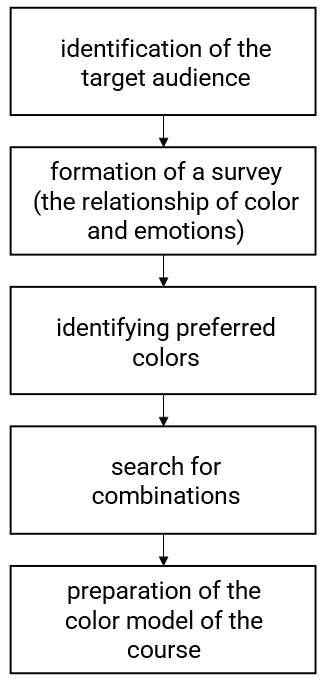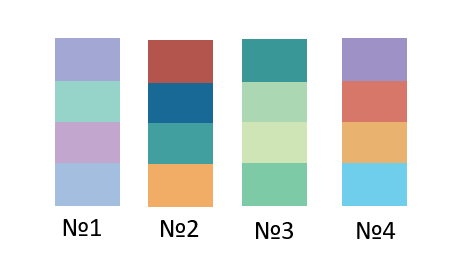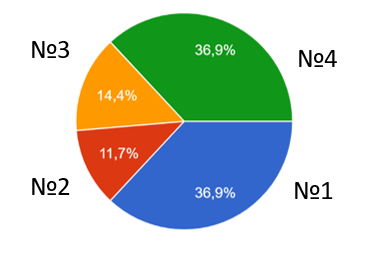Abstract
The use of instructional design in the development of the course of the discipline generates quality content. The article discusses the importance of the formation of colour models for pedagogical design, taking into account the target audience and potential users. The factors that must be taken into account when choosing colour models are given. The visual design of the training course, namely the correctly selected colour scheme, helps to increase the efficiency of information perception. The factors influencing the perception of colour and colour preferences by age group are given. The model of basic emotions is considered and unacceptable emotions are highlighted in the formation of the colour model of the training course. An algorithm for the formation of the colour model of the course of the discipline is given, which consists of five steps: the first step is to select the target audience, the second step is to form a survey (the relationship of colours and emotions), the third step is to identify preferred colours, the fourth step is to search for combinations and the final step is to draw up a course colour model. The colour schemes are given and the schemes are highlighted by the students as the most suitable for the design of the course. The colour model is an important part of the teaching material. The visual component helps to form a competitively capable and attractive educational program. Discipline is an integral part of the educational program and forms attractiveness, interest in acquiring knowledge.
Keywords: Algorithm, colour model, instructional design, visualization
Introduction
The reality is that higher education is a digital university. A digital university assumes the introduction of digital technologies into all processes of the university. First of all, digitalization is applied to the educational process and the electronic course of the discipline is its integral part. Decree of the President of the Russian Federation of May 7, 2018 No. 204 "On national goals and strategic objectives for the development of the Russian Federation for the period up to 2024" includes the creation of a modern and safe digital educational environment that ensures high quality and accessibility of education of all types and levels (O nacional'nyh…, 2018) In addition, the pandemic had a significant impact on the digitalization of education, which forced universities to move online, organize distance learning, including the creation of e-courses (Koinova-Zoellner et al., 2021; Radina & Balakina, 2021) The e-course differs from the traditional full-time course in that students interact with the content independently or/and under the guidance of a tutor (teacher) (Freeling & Auer, 1973; Grechushkina, 2021; Janelli, 2018). and an attractive educational program, quality content is needed.
Recently, the instructional design approach to the development of courses and teaching materials has become widespread. The use of instructional design in the development of a discipline will help to form high-quality content.
Problem Statement
Instructional design is the design, development, and delivery of educational products and experiences, preferably digital (Demidova, 2019; Starodubcev et al., 2019). First of all, the instructional design allows to design a course of a discipline, which in the future is not only aimed at a potential user and target audience, but is also attractive, effective, and as a result, provides the acquisition of the necessary knowledge in a convenient format.
The instructional design aims to continuously improve educational resources and the entire educational space. There are various approaches to the development of pedagogical materials, the choice of models in the development of educational materials, but this article will focus on the formation of colour models. Colour models are used for a wide range of educational materials - for textbooks, teaching aids, presentations, handouts, illustrations, diagrams, videos, and electronic courses as a whole (Demidova, 2019).
The choice of colour model should be made taking into account several factors:
- age of the target audience of the course;
- peculiarities of the target audience perception;
- the possibility of interaction of the target audience with the e-course.
Research Questions
To take into account all of the above facts, it is necessary to research to implement a thoughtful visual design.
Attracting attention is one of the principles of instructional design, namely, motivation for learning, awakening interest in the discipline (in the educational process as a whole) (Demidova, 2019; What …, 2021).
All over the world, approximately 60% of the population perceives everything that happens around them through sight (Kiykova et al., 2018).
Studies show that 90% of the information a person perceives through sight; from a textual description, a person assimilates only 70% of the information, and with the addition of pictures, the result increases to 95% (Kiykova et al., 2017).
Thus, we can conclude that visual design, namely a correctly selected colour scheme, contributes to an increase in the efficiency of information perception. Visualization allows you to present information visually, and, due to the colour, colour the necessary chain for placing the necessary accents, memorizing, and perceiving information.
Purpose of the Study
The purpose of this work is to determine the stages of the algorithm for the formation of colour models for instructional design, which will increase the efficiency of students' perception of information.
Research Methods
When carrying out this work, the following methods were used:
- Analysis of the works of Russian and foreign researchers.
- A survey of 110 students aged 17-22, conducted based on the Vladivostok State University of Economics and Service.
- System analysis to identify and determine the stages of the algorithm for the formation of colour for instructional design.
Findings
The perception of colour is influenced by various factors: age, gender, education, profession, nationality, place of residence, historically established colour cliches. With age, a person's preferences in colours and associations with them change (Freeling & Auer, 1973). In fig. 1 it can be seen that the preference for bright, saturated colours with age changes to the choice of dull, calm tones, as the colour sensitivity decreases (Kiykova et al., 2018).

For each age group, colours have their emotional dimensions and this is where effective content can be built.
For example, in a study conducted based on the Vladivostok State University of Economics and Service (VSUES), for a target audience of 17 to 22 years old, the following ratios of emotion and colour were obtained (Kiykova et al., 2018).
By analysing the table, the most acceptable colours can be selected and compared by colour compatibility and used in the development of instructional design, namely the visual component.
For the learning process, important emotions are joy and surprise (interest): joy gives the energy of communication, and surprise (interest) is curiosity or a desire to learn something new (Bondarenko & Auder, 2015). According to the table, the maximum emotion of joy is caused by yellow, orange and purple colours. The emotion of surprise is caused by purple and orange. Also, important emotions for the learning process are anger (positive excitement) and irritation, which motivate the elimination of obstacles on the way to the goal (Dolzhenko, 2011). The maximum percentage of these emotions is in red. The colours that scored the highest percentage for emotions calmness and satisfaction - blue, cyan, green, black, grey. At the same time, the grey colour causes more unpleasant associations (rain, fog, cloud, gloomy weather) than black (mostly night), so this colour should also be used sparingly. If the design contains only colours that cause a feeling of peace, it will be difficult for students to concentrate on work, since blue, light blue, green are soothing and create a feeling of peace.
Of course, when designing instructional design, the target audience and potential users are highlighted and it is with this data taken into account that it is necessary to conduct a survey and highlight the most acceptable (successful) colours and form the colour model of the discipline. The table does not show all emotions, we recommend expanding it by Table 2, compiled based on Russell's model (Posner et al., 2005). To get the clearest picture and take into account that emotions that are in the category of negative and have low and high intensity are unacceptable when forming the colour model of the course of the discipline.
In addition to this model, it is possible to use the atlas of emotions (Atlas of Emotions, 2021). This atlas distinguishes 5 large groups - universal emotions: sadness, anger, fear, disgust, and enjoyment. Each of the universal emotions includes various states, indicating the intensity is divided into several. For example, for the emotion of enjoyment, the following states are distinguished (in ascending order from low intensity to high intensity): sensory pleasure, joy, gaiety, pride, etc. When using emotions in your research from this source, it should be borne in mind that the most acceptable emotions from colours for learning will be emotions from pleasure groups (with medium intensity) and emotions of the lowest intensity from other groups, and at the same time, such colours should be used minimally.
What are the steps required to form the colour model of the course? To carry out the above study, an algorithm was developed and used to form a colour model of the course and further use it in the design of visual design (Figure 2).

By the proposed algorithm, the first step is to identify the target audience, that is, the students of the course. To implement this stage, it is necessary to conduct an online survey, analyse statistical data to highlight the target audience and potential user. It is necessary to include questions in the survey not only about gender, age group but also about the type of activity since all this will help to form a more accurate picture for instructional design.
The second step is the formation of a survey of students to identify the relationship between colours and emotions. The survey may include an image of colour, a question about the student's emotions caused by colour, ready-made colour models oriented at the target audience and potential user, a question about associations, which will allow identifying the attitude more accurately towards colour. Ready-made colour models can be included during the further revision of the course, taking into account changes in the target audience and potential users.
The third step is the analysis of the results of the survey and identifying preferred colours or patterns.
The next, fourth step, is the search for colour combinations based on the survey results.
The fifth step is to create a colour model for the course. At this point, the course colour scheme designer can use online resources for colour scheme matching, such as colorscheme.ru, color.adobe.com, or canva.com. The listed online resources allow you to choose a suitable colour scheme from a large number of existing ones and also make it possible to create your own, taking into account the colour compatibility. At the same time, tutors do not need to worry about the harmony of the compiled colour schemes, since online resources provide the opportunity to use the rules of colour harmony (monochrome, complementary, triangular schemes, etc.). All steps given in the algorithm are mandatory and cannot be neglected.
At the stage of drawing up the colour model of the course, attention should also be paid to the fact that the colour model should not be monotonous or too dark. For example, when choosing from four different colour schemes (Figure 3), students rated the first and fourth as the most appropriate for the course design.

The second scheme is composed using saturated, dark colours, and the third is composed entirely of shades of green. The first and fourth schemes consist of light shades and have accent colours. Thus, the choice of students was distributed by the diagram in Figure 4.

Students gave the same preference to the first and fourth colour schemes.
Conclusion
As a result, after going through all the stages of the algorithm, we will receive a colour model of the course, but it should be noted that this model is suitable specifically for this target audience and potential user, and maybe unacceptable for another course. This is due to the fact, for example, the target audience can always be between the ages of 17 and 22, but the people participating in the survey may have a different occupation, which also affects the emotional perception of colour.
It is the visual component that helps to form a competitively capable and attractive educational program. Discipline is an integral part of the educational program and forms attractiveness, interest in acquiring knowledge.
The colour model is an important part of the educational material, but other design rules should also be taken into account: conciseness, integrity, consistency.
References
Atlas of Emotions (2021). http://atlasofemotions.org/
Bondarenko, M. V., & Auder, E. V. (2015). Fenomen cvetovyh predpochtenij i nekotorye aspekty ego ispol'zovaniya [The phenomenon of color preferences and some aspects of ist use]. Innovative development of light and textile industry: a collection of materials of the All-Russian Scientific Student Conference, 142-144.
Demidova, I. A. (2019). Pedagogicheskijdizajn i egosredstva: teoreticheskijanaliz i opytprimeneniya v pedagogicheskoj praktike [Tutor’s support of schoolchild’s research activity under the conditions of profile training: purposes, principles, stages. Pedagogy]. Theory & Practice, 4(4), 25-32. https://doi.or/
Dolzhenko, R. A. (2011). Upravlenieemociyamistudentovkakosnovaformirovaniyapozitivnojmotivacii k obucheniyu [Emotions management of students as a form of positive motivation to education]. Tomsk State University Journal. Economy, 1(13), 127-131.
Freeling, G., & Auer, K. (1973). Man – Color – Space. Strojizdat.
Grechushkina, N. V. (2021). Onlajn kurs: modeli primeneniya v obrazovatel'nom processe [Online course application models in the educational process]. Vysshee obrazovanie v Rossii, 4, 120-130.
Janelli, M. (2018). Elektronnoe obuchenie v teorii, praktike i issledovaniyah [E-Learning in Theory, Practice, and Research]. Voprosy obrazovanija, 4, 81-98.
Kiykova, E. V., Sobolevskaya, E. Y., & Kiykova, D. A. (2017). Analiz effektivnosti primeneniya infografiki v uchebnom processe vuza [Analysis of the effectiveness of using infographics in educationa lprocessof the university]. Modern problems of science and education, 6, 222.
Kiykova, E. V., Sobolevskaya, E. Y., & Kiykova, D. A. (2018). Analiz effektivnosti primeneniya infografiki v uchebnom processe vuza [Analysis of color perception of students to develo peffective infographics applied in the educationa lprocess]. Modern high technologies, 11-2, 284-289.
Koinova-Zoellner, J., Kalimullin, A., Gospodinov, B., Prohazka M., & Vasil'eva L. (2021). Pedagogicheskie smysly cifrovogo obucheniya v usloviyah pandemii covid-19: analiz kejsov otdel'nyh vostochno-evropejskih stran [Pedagogical senses of digital learning in the context of the covid-19 pandemic: case studies of several eastern European countries]. Journal of Siberian Federal University. Humanities & Social Sciences, 14(9), 1355-1364.
O nacional'nyhcelyah i strategicheskih zadachah razvitiya Rossijskoj Federacii na period do 2024 goda. Ukaz Prezidenta Rossijskoj Federacii № 204 ot 7 maya 2018 goda [On the national goals and strategic tasks of the developmentof the Russian Federation for the period upto 2024. Decree of the President of the Russian Federation No. 204 dated May 7, 2018] (2018). https://www.garant.ru/products/ipo/prime/doc/71837200/
Posner, J., Russell, J. A., & Peterson, B. S. (2005). The circumplex model of affect: An integrative approach to affective neuro science, cognitive development, and psychopathology. Development and Psychopathology, 17(3), 715-734.
Radina, N. K., & Balakina, Ju. V. (2021). Challenges for education during the pandemic: an overview of literature. Educational Studies Moscow, 1, 178-194.
Starodubcev, V. A., Sitnikova, O. V., & Lobanenko, O. B. (2019). Optimizaciya kontenta onlajn-kursa po dannym statistiki aktivnosti pol'zovatelej [Content optimization Online course based on user activity statistics]. Vysshee obrazovanie v Rossii, 8-9, 119-127.
What is pedagogical design? (2021). https://www.ispring.ru/elearning-insights/chto-takoe-pedagogicheskiy-dizayn
Copyright information

This work is licensed under a Creative Commons Attribution-NonCommercial-NoDerivatives 4.0 International License.
About this article
Publication Date
03 June 2022
Article Doi
eBook ISBN
978-1-80296-125-6
Publisher
European Publisher
Volume
126
Print ISBN (optional)
-
Edition Number
1st Edition
Pages
1-1145
Subjects
Social sciences, education and psychology, technology and education, economics and law, interdisciplinary sciences
Cite this article as:
Sobolevskaya, E. Y., & Kiykova, D. A. (2022). Algorithm For The Formation Of Colour Models For Pedagogical Design. In N. G. Bogachenko (Ed.), AmurCon 2021: International Scientific Conference, vol 126. European Proceedings of Social and Behavioural Sciences (pp. 905-913). European Publisher. https://doi.org/10.15405/epsbs.2022.06.100

